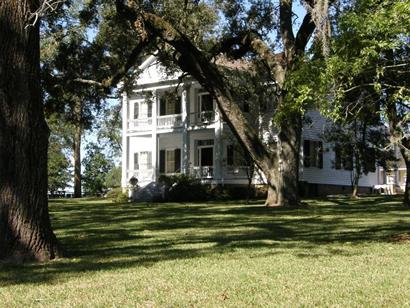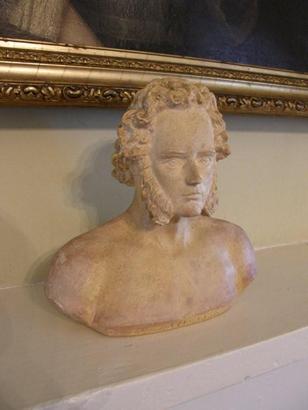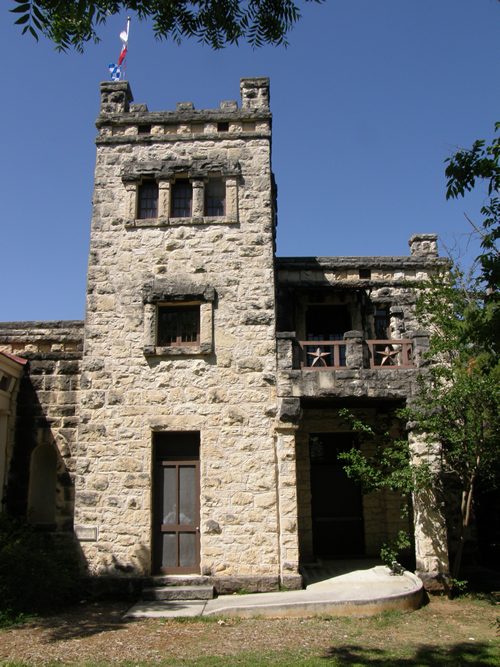|
Texas
| Ghosts
LOVE IN THE
TIME OF DIPHTHERIA
or
Art and Science on the Brazos
“Miss”
Elisabet Ney,
Dr. Edmund Montgomery and
The Haunting of Liendo Plantation
by Luke Warm |
Editor’s
Note: For many years now the most notable landmark (read
eyesore) of Hempstead,
Texas has been a large car dealership where they (allegedly) “clobber
big city prices.” Now that commercial development has all but abandoned
downtown Hempstead
to cater to the just-passing-through crowd, its ugliness is now encroaching
upon a true historic landmark – the 1853 plantation of Liendo. As
the crow flies, the house is not a half- mile from the highway and
fast food restaurants are even closer.
Famous for its ante-bellum history as much as it’s role in the Civil
War, the home once belonged to a rather unusual European couple. She
was a famed German sculptress and he a Scottish physician / philosopher.
The clash of interests and strong personalities was bound to produce
an epic Texas tale. But instead, it turned into a saga of loneliness,
separate rooms, unshared success, and one of Texas’ most unusual ghost
stories. |
 |
In
1830 José Justo Liendo purchased eleven leagues of land from
the Mexican government near present-day Hempstead
(About 40 miles NW of Houston).
In 1841 Leonard Waller Groce purchased half of this tract and
bought the remaining half in 1860. The price for both came to less
than $3,000. Groce is a historical footnote in the Texas Revolution
for ferrying Houston’s army across the Brazos on the way to San
Jacinto.
Groce started cultivating the land and in 1853 built a grand house
which he magnanimously named after the property’s former owner. |
| Terry Gurley
(l) and Michele Ann Wendt on the front steps of Liendo. If you could
order docents from a catalog, they couldn't come any better. |
Hand-crafted
Brazos River Mud
TE photo |
| Built by Groce’s
slaves, the foundation of the house was constructed of handmade bricks
formed of Brazos River clay. The interior details include a hand-carved
banister, long leaf pine floors and stenciled ceilings. |
The hand-painted
ceiling of the drawing room is mix of roses and morning glories.
TE photo
|
Groce built a
school for his and his neighbor’s children (no longer extant) and
with an annual income estimated to be close to six figures, he was
able to turn Liendo into a popular overnight stop for the rich and
famous of the day. (There is a reason why the Sam
Houston bedroom is called the Sam Houston bedroom.)
During the Civil War, Camp Groce, a Confederate recruiting
station, was established at Liendo. Later, in the final days of the
Civil War, it was turned into a Confederate prisoner-of-war camp.
For three months during Reconstruction (Sept. to Dec. 1865), Gen.
George A. Custer camped at Liendo. |
| General Custer
remembering happier days at Liendo |
On the inside
looking out at "Groce's Folly" - the cistern-fed fountain
that never quite worked.
TE photo
|
| Without slaves,
the plantation was cast into dire straits and Groce was bankrupt by
1868. In 1873 Leonard W. Groce, Jr., sold 1,100 acres of the property
to Elisabet Ney and Dr. Edmund D. Montgomery for $10,000.
|
A self-carved
bust of the sculptor
TE photo
|
| The
new owners had interests other than bringing in a cotton
crop. They had first tried their hands at farming in Georgia with
little success other than producing two sons (Arthur and Lorne). Both
Ney and Montgomery were already famous in Europe. Elisabet for sculpting
the heads of state, musicians and authors and Edmund for practicing
medicine in nearly every European capital. But their Continental reputation
cut little (if any) bait in Hempstead,
a town that was once known as "Six-shooter Junction." Their
lifestyle was looked upon with suspicion. Elisabet wore togas and
turbans and frequently dressed Lorne the same way. In Hempstead,
circa 1875, fashion was a statement – not a question. Went visiting
town, Lorne’s velvet britches made him a laughing stock among the
canvas and dungaree-wearing crowd of Six-shooter Junction. |
 |
|
Physician, Scientist,
Philosopher &
Secretary of the Waller County Melon Growers Association, Dr. Montgomery's
bust is about one tenth the size of Miss Ney's. Michele Wendt refers
to the diminutive bust as a "wallet-sized" sculpture.
TE photo
|
Montgomery kept
busy with a vibrant and constant correspondence with his fellow scientists
in Europe and Elisabet set aside her art for nearly 20 years. It was
during this period that son Arthur contracted Diphtheria, which was
then making the rounds of coastal
Texas.
Doctor Montgomery knew enough to quarantine the house from the townsfolk,
but his extensive medical knowledge wasn’t enough to save little Arthur’s
life. After a few days of raging fever, their little boy was gone.
Knowing the threat of contagion, it was decided to cremate Arthur
and legend has it that this unpleasant task was performed in the drawing
room fireplace. |
The (alleged)
crematorium
TE photo
|
| The
fact that Arthur’s ashes were placed in an urn over the mantle is
undisputed. But it’s not the boy’s cremation that got the family included
in the late Ed Sayer’s Ghosts of Texas. It’s the cries
of little Arthur that some say are still heard at night – coming from
the estates "gentleman's quarters" - the unattached lodging
for single male guests. |
A plaster study
of Lorne’s forearm was discovered in Liendo’s attic years after Ney’s
death.
TE photo
|
Sursum
Ney's sculpture entitled Sursum now adorns her Austin
studio. Sursum is Latin for "Upward."
TE photo
|
No one can say
when the “haunting” of Liendo started, but between the eccentric
lifestyle of the foreign couple, the spooky landscape and the fact
that it was once a prisoner of war camp, the locals didn’t have to
use too much of their collective imagination to conjure up stories
of active spirits at Liendo.
Other Spirits,
Other Rooms
Besides baby
Arthur, there are reportedly several other entities on the property.
A benevolent female spirit has been known to visit the foot of the
bed in the Sam Houston
room inquiring about a guest’s comfort while another presence (thought
to be Miss Ney herself) pulls the covers off of some guests.
Michelle Wendt
relates a more chilling tale: "There is another story I was
told. As I remember it, two guests were staying in separate rooms,
experiencing a fitful night because of a Texas heat wave. In one
room the air suddenly cooled and what [one guest] thought was her
friend coming in the room circled her bed then climbed in. By morning
"the friend" was gone, and when she asked their host at breakfast
if the air conditioning had been turned on, she received the reply
that it wasn't working. She then asked her friend "did you climb
in my bed?" Her friend said "no, I stayed in my room all night
and couldn't sleep because of the heat.... "
|
 |
| The
property was not properly maintained and after Elizabet moved to Austin
to her fortress
/ studio, Edmund became known as the “hermit philosopher.” He
did sometimes support local education and served the nearby community
– but not as a physician. He once served as the Secretary of the Waller
County Melon Grower’s Association – which in Hempstead
is a prestigious position indeed. |
Elisabet died
in June of 1907 and Edmund suffered a stroke just two months later.
He remained an invalid until his death in 1911 shortly after publishing
his magnum opus, Philosophical Problems in the Light of Vital Organization.
Dr. Montgomery was interred in an unmarked plot – presumably alongside
Ney’s gravesite. It is said that the urn containing the ashes of little
Arthur were interred with his father. |
Docents Wendt
and Gurley flank the gate to the “family” cemetery where Ney, her
husband and a granddaughter are interred with several former property
owners.
TE photo
|
| A modest inscription
for an accomplished artist. |
|
According to
docent Wendt, Elisabet Ney referred to her self as a sculptor, not
sculptress.
TE photo
|
One of Liendo's
resident cats, "Cali" inspects a potential draft
All TE photos, October 2008 |
A 1936 Texas
Centennial Marker stands in front of a rare (in Texas) Walnut
tree estimated to be 500 years old. The tree still produces fruit
for Liendo's abundant
squirrel population.
TE photo
|
Another Walnut
tree was uprooted by Hurricane Ike in Sept 2008.
TE photo
|
Liendo's
balcony where Elisabet
Ney proclaimed that it would be her home. The iron fountain (just
left of center) was known as Groce's Folly. Gravity-fed from a cistern
behind the house, it never worked properly. It is said that the lead
pipe carrying the water was "mined" for Confederate musket
balls during the Civil War.
TE
photo |
Ney
traveled between Liendo
and Austin alone in a buggy
hired from a Hempstead
livery stable. Part of her luggage always included this metal bathtub.
TE photo
|
Liendo
is also a working ranch and home to a beautiful herd of Red Brahma
cattle as well as a flock of peafowl. If spirits
walk the grounds of Liendo,
these are probably the best witnesses, but unfortunately, they aren't
talking.
TE photo
|
The painstakingly
restored Liendo Plantation is available for tours on the first Saturday
of every month and plays host to a “Civil War Weekend” the weekend
before Thanksgiving. Visit their website for more detailed information:
www.liendoplantation.com
TE photos
© John
Troesser
October,
2008 Feature |
| Texas
Escapes, in its purpose to preserve historic, endangered and vanishing
Texas, asks that anyone wishing to share their local history, stories,
landmarks and recent/vintage/historic photos, please contact
us. |
|
|
